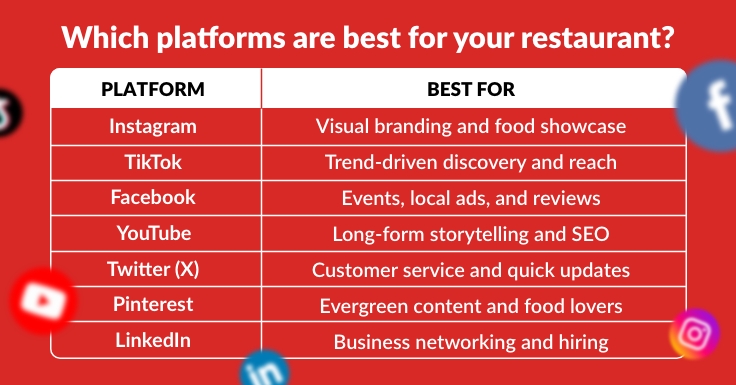The Top 7 Social Media Platforms UK Restaurants Should Focus on in 2025


Social media has evolved far beyond just sharing snapshots of latte art or burger stacks. In 2025, it’s your digital shopfront, your community builder, and your most cost-effective marketing channel. Whether you’re running a brunch spot in Brighton or a fine-dining restaurant in Leeds, a strong presence across the right platforms can drive footfall, repeat business, and online orders.
But here’s the key: you don’t need to be everywhere—just in the right places. Here are the top 7 social media platforms restaurants in the UK should focus on in 2025, with strategies tailored to each.
If your food doesn’t look good on Instagram, does it even exist? With over 30 million users in the UK, it remains the go-to platform for discovering new restaurants, drooling over dishes, and planning that next meal out.
Pro tip: Use a consistent filter or style to establish a strong brand identity. And don’t forget to add links to your Foodhub ordering page or website in your bio.
The fastest-growing platform in hospitality marketing, TikTok is where creativity thrives. With over 20 million UK users (mostly under 35), it’s a powerful channel for reach, authenticity, and viral momentum.
Pro tip: You don’t need high production—just personality, good lighting, and trending audio. Utilize captions and hashtags to increase visibility and discovery.
While younger diners may have moved to TikTok, Facebook remains one of the most important platforms for event marketing, local SEO, and community engagement, especially for audiences 30+.
Pro tip: Maintain your Facebook page with updated hours, a link to your ordering platform, and high-quality images—it often shows up in search results alongside Google.
While YouTube requires more effort than other platforms, the payoff is in depth and longevity. It’s the second-largest search engine (after Google), and video content has a long shelf life.
Pro tip: Embed your YouTube content into your Foodhub website or blog. It keeps visitors engaged longer and boosts SEO.
Despite rebranding as X, Twitter remains a valuable tool for restaurants, especially for fast-paced communication, witty branding, and customer interaction.
Pro tip: Be reactive and consistent. Monitor mentions, respond quickly, and pin a tweet with your ordering link or most recent promotion.
Often overlooked, Pinterest works like a visual search engine—and it's especially effective for food, recipes, and design inspiration. It can drive steady, organic traffic to your website and menu pages.
Pro tip: Pinterest content can last for months, sometimes even years. Optimise pin titles and descriptions with relevant keywords (e.g., “Best brunch spots in Manchester”).
While not a typical marketing platform, LinkedIn is ideal for B2B interactions, hiring staff, and sharing your restaurant's business journey.
Pro tip: Use LinkedIn to connect with Foodhub, industry partners, or suppliers. It adds credibility and demonstrates your active involvement in the hospitality community.
Not every platform is for everyone. Here's a simplified guide.

Focus on 2–3 platforms where your audience is most active and where you can consistently create content.
If you're directing people to third-party apps with high commission fees, your social success could be costing you.
With Foodhub, you get:
Social media success in 2025 doesn’t mean being on every channel—it means showing up consistently where it counts, sharing your story, and giving people a reason to visit, order, and return.
Whether it’s a viral TikTok, a heartfelt Instagram Reel, or a thoughtful LinkedIn post, your restaurant’s story deserves to be told—and shared.
Partner with Foodhub to create your own branded restaurant site and app—with no commissions, no hidden fees, and full support from day one.